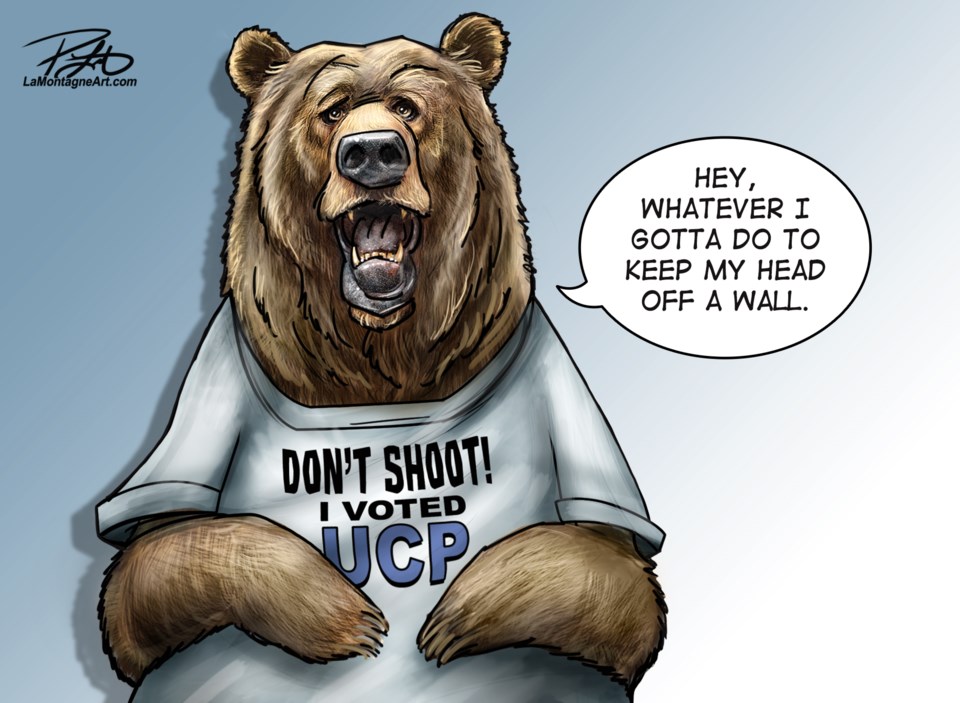The statistics used by the province to argue the need for the return of the grizzly bear hunt were always suspicious.
With conservationists and grizzly bear experts questioning Minister of Forestry and Parks Todd Loewen’s statistics of 20 problem grizzlies annually having a negative human interaction, newly released data from the province further questions that number.
It’s easy to call out a provincial minister for misconstruing factual information or not fully understanding all available data.
However, it leads to an important question of whether the information received was adequate in making a wholesale policy change.
The statistics of 20 problem grizzlies each year were given by Loewen when he was doing damage control after it became known a new form of the grizzly bear hunt was returning.
It’s the latest failure on wildlife-related policy by a provincial government that seemingly makes decisions not based on facts, but spinning the roulette wheel to determine its next move.
According to statistics quietly released by the province in late August, from 2013-22 there were 23 grizzlies killed in self-defence and 57 for agency removal. For those counting, that’s significantly fewer than Loewen’s claim of 20 annual problem grizzlies in a negative human interaction.
During those 10 years, there were 235 grizzlies killed by humans ranging from getting hit by a vehicle, illegal kills, people thinking it was a black bear and treaty harvest.
The grizzly bear recovery plan and the last updated grizzly bear status report in 2022 had two to three grizzly bears a year euthanized because of human-bear conflict.
Not only have conservationists and grizzly bear experts questioned Loewen’s information, but provincial data also calls out the minister’s ill-informed statement he said he received from wildlife experts.
Loewen has said up to 15 problem grizzlies could be shot each year under the new policy, but there’s no evidence that gunning bears down by the dozen will solve extreme human-bear conflicts.
The proven way to mitigate conflict has been reducing fruit attractants, securing garbage, banning bird feeders and removing other types of food that can entice bears.
From 2009-20, there were 12 grizzly bear euthanizations in bear management areas 4, 5 and 6, which includes Canmore, Kananaskis Country and surrounding areas.
The grizzly bear hunt was tossed in 2006 and they were listed as a threatened species by the province in 2010. They had first been recommended to be a threatened species in 2002.
After the hunt was ditched, the grizzly bear population slowly increased and province-wide census had them between 856-973.
The provincial government quietly amended the Wildlife Act in June through a ministerial order to allow adult Alberta residents the ability to buy a licence approved by the Minister of Forestry and Parks.
The licence allows its holder the ability to kill a bear deemed a public safety threat by a wildlife officer within a 24-hour window. As part of the change, a pool of potential people will be created.
Rather than fill staff positions meant to specialize in human-wildlife conflicts – that have been empty since 2022 – the province has deemed shooting first and asking questions later better policy.
There have been cases of grizzly bears killing people.
One high profile instance was in 2023 in Banff National Park when a non-lactating 25-year-old female killed a couple and their dog.
It’s safe to say the majority – if not all – conservationists would understand having to euthanize that grizzly bear.
Other examples, however, have seen people hunting grizzlies simply lose when it comes to human vs. bear. It’s not that certain grizzlies become problems in those scenarios, but that they beat the person hunting them.
When a person uses incorrect information to mislead people, they should publicly apologize.
A policy made from incorrect information should also be reversed and sent back to the drawing board for further study and rigorous public engagement.
Without such an apology or reversal of policy, anything Loewen says as an elected official should forever be tainted.




